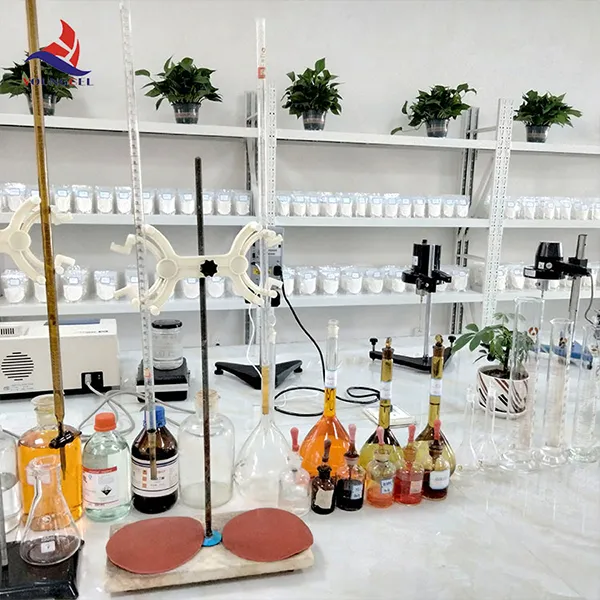The Role of Hydroxypropyl Methylcellulose in Adhesive Formulations
Introduction
In the domain of adhesives, the choice of polymeric components is critical to achieving desired performance characteristics. One polymer that has gained significant attention in recent years is hydroxypropyl methylcellulose (HPMC). This versatile cellulose ether not only enhances adhesive properties but also boasts unique attributes that make it suitable for various applications across industries. In this article, we will delve into the properties, functions, and applications of HPMC in adhesive formulations.
Understanding Hydroxypropyl Methylcellulose
Hydroxypropyl methylcellulose is a semi-synthetic polymer derived from cellulose, which is one of the most abundant organic polymers on earth. The molecule is modified by introducing hydroxypropyl and methoxy groups, which significantly alters its physical and chemical properties. HPMC is known for its solubility in water, forming a clear, viscous solution, and its ability to thicken, stabilize, and modify the rheology of formulations.
Properties of HPMC
1. Non-Toxicity and Biocompatibility HPMC is considered safe for use in a variety of applications, including pharmaceuticals and food products. Its non-toxic nature makes it an ideal choice for consumer products that come into contact with skin or are ingested.
2. Thermal Stability HPMC possesses good thermal stability, allowing it to maintain its properties under varying temperature conditions, which is essential for adhesives that may be used in fluctuating environments.
3. Water Retention One of the prominent features of HPMC is its excellent water retention ability. This property is particularly beneficial in adhesives, providing sufficient working time and preventing premature drying.
4. Viscosity Modification HPMC can effectively modify the viscosity of adhesive formulations. By adjusting the concentration of HPMC, manufacturers can tailor the rheological properties to suit specific application requirements, such as the ability to flow easily or to remain thick and stable.
Functions of HPMC in Adhesive Formulations
chemic adhes hpmc

1. Thickening Agent HPMC acts as a thickening agent in adhesive formulations, providing the necessary texture and ensuring that the adhesive stays in place during application.
2. Binder In many adhesive formulations, HPMC serves as a binder that helps in holding the other components together, thereby improving the overall cohesion and bond strength of the adhesive.
3. Film Forming When the adhesive dries, HPMC contributes to the formation of a continuous film, essential for creating strong adhesion between substrate surfaces. This film also acts as a barrier to moisture and enhances overall durability.
4. Open Time Extension By retaining moisture, HPMC extends the open time of adhesives, allowing users more flexibility during application. This is particularly important in construction and assembly where precise alignment is crucial.
Applications of HPMC-Based Adhesives
1. Construction Industry HPMC is widely used in construction adhesives, particularly in tile and flooring adhesives, where its properties enhance adhesion to various substrates, improve workability, and allow for longer setting times.
2. Pharmaceuticals In the pharmaceutical realm, HPMC-based adhesives are significant for drug delivery systems, such as transdermal patches, where effective adhesion and controlled release are paramount.
3. Food Industry Food-grade HPMC is utilized as an adhesive in packaging. Its non-toxic nature ensures safety for products that may come into contact with food items.
4. Personal Care Products HPMC is also found in the formulation of personal care products, where it serves as an adhesive in various applications, including cosmetic products and skin care formulations.
Conclusion
Hydroxypropyl methylcellulose is a powerful component in adhesive formulations, offering versatile properties that enhance performance across a range of applications. Its non-toxic nature, excellent thickening abilities, and water retention characteristics make it an invaluable resource in industries ranging from construction to pharmaceuticals. As the demand for high-performance adhesives continues to grow, HPMC will likely play an increasingly important role in developing innovative adhesives that meet the needs of modern applications. The ongoing research and advancements in the development of HPMC-based formulations promise exciting prospects for the future of adhesive technologies.
-
A Comprehensive Guide to Methyl Ethyl Hydroxyethyl Cellulose: Applications and Industry InsightsNewsNov.24,2025
-
Understanding Methyl 2 Hydroxyethyl Cellulose: Uses, Benefits & Industry InsightsNewsNov.24,2025
-
Hydroxyethyl Methyl Cellulose HEMC: Industrial Uses, Benefits & Future TrendsNewsNov.23,2025
-
HEMC Cellulose: Versatile & Sustainable Industrial Polymer | YoungcelNewsNov.23,2025
-
Methyl Hydroxyethyl Cellulose: Versatile Building Block for Industry & SustainabilityNewsNov.23,2025
-
CAS 9032 42 2: Understanding Polyvinyl Alcohol's Impact on Industry & SustainabilityNewsNov.22,2025




